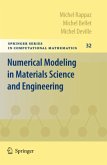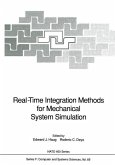Apostol Poceski
Mixed Finite Element Method
Apostol Poceski
Mixed Finite Element Method
- Broschiertes Buch
- Merkliste
- Auf die Merkliste
- Bewerten Bewerten
- Teilen
- Produkt teilen
- Produkterinnerung
- Produkterinnerung
In this book, based on 16 years of work on the finiteelement method, the author presents the essence of a new,direct approach to the FEM. The work is focused on themixed method and shows how reliable results may be obtainedwith fewer equations than usual.The basic principles, the fundamentals and the essence ofthe FEM are presented, then the method is applied to theanalysis of one, two, and three-dimensional problems. It isshown that mixed elements offer superior accuracy comparedwith stiffness elements. Finally, some new achievementsand perspectives for further development are presented.The…mehr
Andere Kunden interessierten sich auch für
![Numerical Modeling in Materials Science and Engineering Numerical Modeling in Materials Science and Engineering]() Michel RappazNumerical Modeling in Materials Science and Engineering150,99 €
Michel RappazNumerical Modeling in Materials Science and Engineering150,99 €![Real-Time Integration Methods for Mechanical System Simulation Real-Time Integration Methods for Mechanical System Simulation]() Real-Time Integration Methods for Mechanical System Simulation115,99 €
Real-Time Integration Methods for Mechanical System Simulation115,99 €![Mixed Finite Element Technologies Mixed Finite Element Technologies]() Mixed Finite Element Technologies80,99 €
Mixed Finite Element Technologies80,99 €![Mixed Finite Element Technologies Mixed Finite Element Technologies]() Peter Wriggers / Carsten Carstensen (Volume editor)Mixed Finite Element Technologies75,99 €
Peter Wriggers / Carsten Carstensen (Volume editor)Mixed Finite Element Technologies75,99 €![Nichtlineare Finite-Element-Methoden Nichtlineare Finite-Element-Methoden]() Peter WriggersNichtlineare Finite-Element-Methoden64,99 €
Peter WriggersNichtlineare Finite-Element-Methoden64,99 €![Nonlinear Finite Element Methods Nonlinear Finite Element Methods]() Peter WriggersNonlinear Finite Element Methods97,99 €
Peter WriggersNonlinear Finite Element Methods97,99 €![Finite Element Methods for Engineering Sciences Finite Element Methods for Engineering Sciences]() Joel ChaskalovicFinite Element Methods for Engineering Sciences38,99 €
Joel ChaskalovicFinite Element Methods for Engineering Sciences38,99 €-
-
-
In this book, based on 16 years of work on the finiteelement method, the author presents the essence of a new,direct approach to the FEM. The work is focused on themixed method and shows how reliable results may be obtainedwith fewer equations than usual.The basic principles, the fundamentals and the essence ofthe FEM are presented, then the method is applied to theanalysis of one, two, and three-dimensional problems. It isshown that mixed elements offer superior accuracy comparedwith stiffness elements. Finally, some new achievementsand perspectives for further development are presented.The book is intended for undergraduate and graduatestudents, mathematicians, research engineers and practicingengineers. To understand the book, a familiarity withclassical mechanics is sufficient.
Hinweis: Dieser Artikel kann nur an eine deutsche Lieferadresse ausgeliefert werden.
Hinweis: Dieser Artikel kann nur an eine deutsche Lieferadresse ausgeliefert werden.
Produktdetails
- Produktdetails
- Lecture Notes in Engineering .72
- Verlag: Springer / Springer Berlin Heidelberg / Springer, Berlin
- Artikelnr. des Verlages: 978-3-540-54916-1
- Softcover reprint of the original 1st ed. 1991
- Seitenzahl: 360
- Erscheinungstermin: 17. Dezember 1991
- Englisch
- Abmessung: 242mm x 170mm x 20mm
- Gewicht: 615g
- ISBN-13: 9783540549161
- ISBN-10: 3540549161
- Artikelnr.: 36111625
- Herstellerkennzeichnung Die Herstellerinformationen sind derzeit nicht verfügbar.
- Lecture Notes in Engineering .72
- Verlag: Springer / Springer Berlin Heidelberg / Springer, Berlin
- Artikelnr. des Verlages: 978-3-540-54916-1
- Softcover reprint of the original 1st ed. 1991
- Seitenzahl: 360
- Erscheinungstermin: 17. Dezember 1991
- Englisch
- Abmessung: 242mm x 170mm x 20mm
- Gewicht: 615g
- ISBN-13: 9783540549161
- ISBN-10: 3540549161
- Artikelnr.: 36111625
- Herstellerkennzeichnung Die Herstellerinformationen sind derzeit nicht verfügbar.
1. Basic Principles.- 1.1. Introduction.- 1.2. The principle of virtual displacements.- 1.3. The unit force theorem.- 1.4. The unit displacement theorem.- 1.5. Energy variational principles.- 2. Fundamentals of the Finite Element Method.- 2.1. Historical development of the method.- 2.2. The concept of analysis by the finite element method.- 2.3. Energetic approaches of development of finite elements.- 2.4. Application of the unit displacement and unit force theorems.- 2.5. Energetic approach by boundary integration.- 2.6. The essence of the method.- 2.7. Isoparametric formulation.- 2.8. The direct method of development of finite elements.- 2.9. The progress of the mixed method.- 3. The Mixed Method in Analysis of Beam Systems.- 3.1. Introduction.- 3.2. Mixed beam element.- 3.3. Analysis of beam systems.- 3.4. Beam on elastic supports.- 3.5. Dynamics of beams.- 3.6. Stability of the beam systems.- 3.7. Coupled action of axial and transverse forces.- 4. Plate Bending Analysis.- 4.1. Rectangular element with independently assumed displacements and moments.- 4.2. Compatible element derived by boundary integration.- 4.3. Rectangular element derived by the direct method.- 4.4. Accuracy of the rectangular elements.- 4.5. Element for analysis of moderately thick plates.- 4.6. Isoparametric formulation.- 4.7. Quadrilateral element.- 4.8. Quadratic isoparametric element.- 4.9. Curved boundary element of complex displacement function.- 4.10. Accuracy of isoparametric elements.- 4.11. Practical application.- 4.12. Dynamics of plates.- 4.13. Stability of plates.- 5. Two-Dimensional Problems.- 5.1. Differential equations of the problems.- 5.2. Shortcomings of the previously developed elements.- 5.3. Rectangular mixed plane stress element.- 5.4. Quadrilateral element.- 5.5. Element ofcurved contours.- 5.6. Convergency and accuracy of the presented elements.- 6. Shells.- 6.1. Differential equations of shells.- 6.2. Mixed rectangular element.- 6.3. Analysis of dome shell.- 6.4. Analysis of cylindrical roof shell.- 6.5. Analysis of cylindrical pipe.- 6.6. Analysis of hyperbolic paraboloid shell.- 6.7. Comments and tasks for further research.- 7. Three-Dimensional Elements.- 7.1. Introduction.- 7.2. Three-dimensional elements.- 7.3. Mixed element of 36 d.o.f..- 7.4. Prismatic element of 36 d.o.f..- 7.5. Reduced three-dimensional element for plate bending analysis.- 7.6. Analysis of thick plates.- 7.7. Further development of three-dimensional elements.- 8. Further Development of the Finite Element Method.- 8.1. From one-dimensional to two-dimensional elements; accuracy.- 8.2. Displacement interpolation function.- 8.3. On the degrees of freedom.- 8.4. Some remarks on the application of the energy variational principles.- 8.5. The mathematical (direct) approach of development of finite elements.- 8.6. Application of the FEM for solution of different problems.- 8.7. Further development of the mixed method.- References.
1. Basic Principles.- 1.1. Introduction.- 1.2. The principle of virtual displacements.- 1.3. The unit force theorem.- 1.4. The unit displacement theorem.- 1.5. Energy variational principles.- 2. Fundamentals of the Finite Element Method.- 2.1. Historical development of the method.- 2.2. The concept of analysis by the finite element method.- 2.3. Energetic approaches of development of finite elements.- 2.4. Application of the unit displacement and unit force theorems.- 2.5. Energetic approach by boundary integration.- 2.6. The essence of the method.- 2.7. Isoparametric formulation.- 2.8. The direct method of development of finite elements.- 2.9. The progress of the mixed method.- 3. The Mixed Method in Analysis of Beam Systems.- 3.1. Introduction.- 3.2. Mixed beam element.- 3.3. Analysis of beam systems.- 3.4. Beam on elastic supports.- 3.5. Dynamics of beams.- 3.6. Stability of the beam systems.- 3.7. Coupled action of axial and transverse forces.- 4. Plate Bending Analysis.- 4.1. Rectangular element with independently assumed displacements and moments.- 4.2. Compatible element derived by boundary integration.- 4.3. Rectangular element derived by the direct method.- 4.4. Accuracy of the rectangular elements.- 4.5. Element for analysis of moderately thick plates.- 4.6. Isoparametric formulation.- 4.7. Quadrilateral element.- 4.8. Quadratic isoparametric element.- 4.9. Curved boundary element of complex displacement function.- 4.10. Accuracy of isoparametric elements.- 4.11. Practical application.- 4.12. Dynamics of plates.- 4.13. Stability of plates.- 5. Two-Dimensional Problems.- 5.1. Differential equations of the problems.- 5.2. Shortcomings of the previously developed elements.- 5.3. Rectangular mixed plane stress element.- 5.4. Quadrilateral element.- 5.5. Element ofcurved contours.- 5.6. Convergency and accuracy of the presented elements.- 6. Shells.- 6.1. Differential equations of shells.- 6.2. Mixed rectangular element.- 6.3. Analysis of dome shell.- 6.4. Analysis of cylindrical roof shell.- 6.5. Analysis of cylindrical pipe.- 6.6. Analysis of hyperbolic paraboloid shell.- 6.7. Comments and tasks for further research.- 7. Three-Dimensional Elements.- 7.1. Introduction.- 7.2. Three-dimensional elements.- 7.3. Mixed element of 36 d.o.f..- 7.4. Prismatic element of 36 d.o.f..- 7.5. Reduced three-dimensional element for plate bending analysis.- 7.6. Analysis of thick plates.- 7.7. Further development of three-dimensional elements.- 8. Further Development of the Finite Element Method.- 8.1. From one-dimensional to two-dimensional elements; accuracy.- 8.2. Displacement interpolation function.- 8.3. On the degrees of freedom.- 8.4. Some remarks on the application of the energy variational principles.- 8.5. The mathematical (direct) approach of development of finite elements.- 8.6. Application of the FEM for solution of different problems.- 8.7. Further development of the mixed method.- References.









